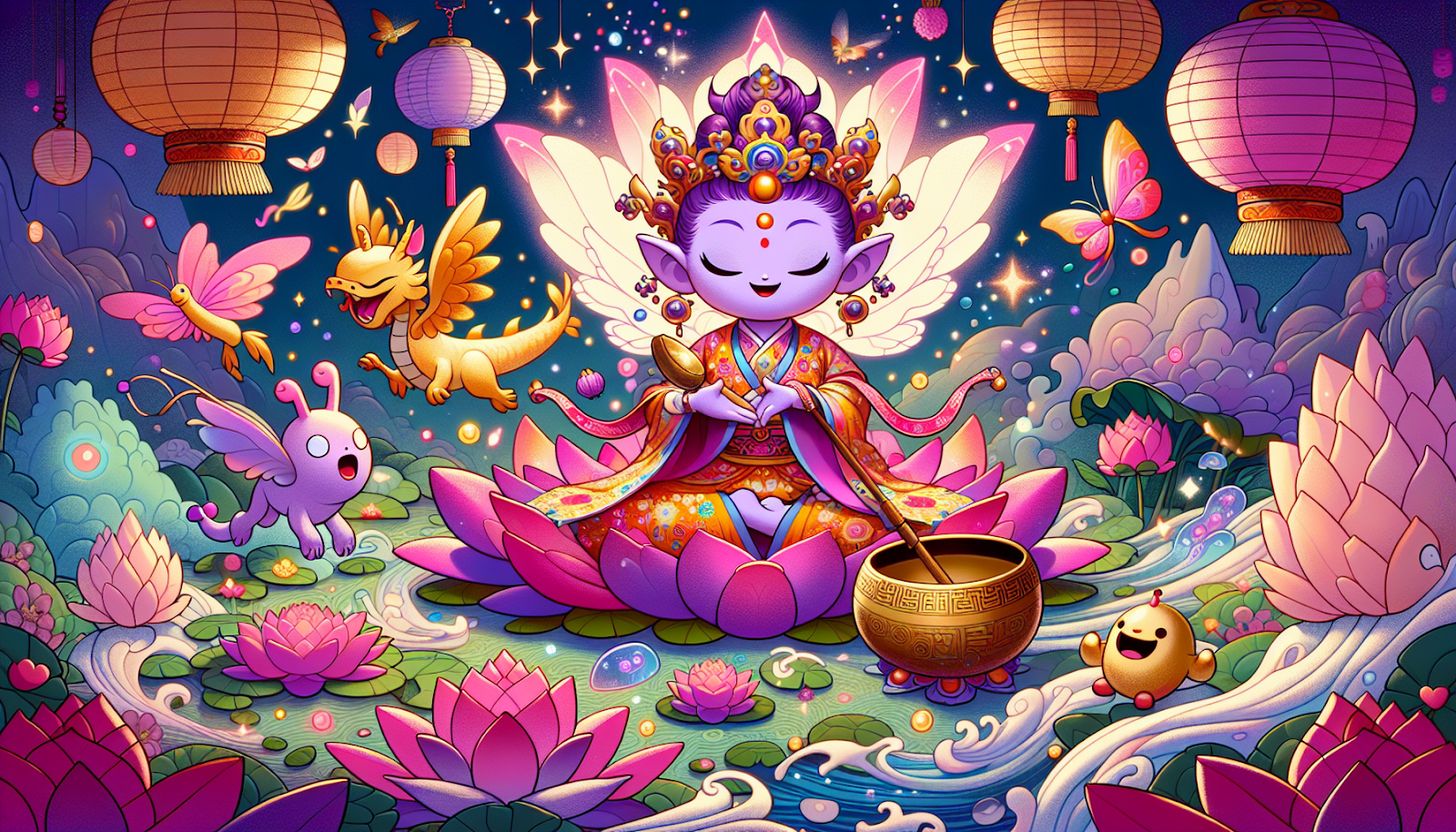The Brahmaviharas: How To Become Free From Afflictive Thoughts and Emotions Forever

Afflictive thoughts and emotions are an inevitable part of human experience. As a Bodhisattva Magician, they are also incredible opportunities for growth and transformation. By working with the wholesome states of the Brahmaviharas, or the "divine abodes" of Buddhism—loving-kindness (metta), compassion (karuna), sympathetic joy (mudita), and equanimity (upekkha)—you can dissolve afflictive mental and emotional disturbances and easily cultivate a state of happiness, joy, clarity, peace, and presence.
These practices empower you to transform any arising at any level, be it an afflictive thought, an afflictive emotion, or a difficult experiential into joyous, peaceful, happy states that radiate benefit to anyone and everyone.
What Are Afflictive Thoughts and Afflictive Emotions?

Afflictive thoughts and emotions are defined by the characteristic of grasping and clinging, regardless of whether they seem "positive" or "negative." They arise when we fixate on an experience, thought, or feeling in a way that pulls us out of alignment with the present moment.
- Afflictive Thoughts: These are clinging thoughts tied to attachment, resistance, or fixation. Whether it’s ruminating on an injustice, replaying a pleasant memory, or fantasizing about future outcomes, afflictive thoughts carry the subtle (or not-so-subtle) energy of clinging and grasping, making them a source of tension and stickiness. These thoughts are characterized by their ability to pull you into them, forcing your mind to feed them energy and attention.
- Afflictive Emotions: These emotions arise with the flavor of grasping, such as craving, jealousy, anger, or even excessive excitement. What makes them afflictive is not their emotional tone but the way they distort our ability to rest in the flow of the present moment, tethering us to attachment or aversion. We can notice that these emotions don’t ask our permission to enter our reality and control our experience, they are intruders on our present moment flow.
The problem with attachment is that it pulls us out of the present moment with irrelevant and dissociative thoughts and feelings. You can notice that you’re never truly present when an afflictive emotion or thought is arising, it’s always taking you away from your present moment experience. By recognizing afflictive states through their grasping quality, we can begin to work with them skillfully, dissolving their hold and cultivating a deeper connection to clarity and ease.
The Most Powerful Buddhist Meditation: The Brahmaviharas

The Brahmaviharas are wholesome, expansive mental and emotional states that counteract afflictive patterns. Each Brahmavihara serves as a specific antidote to a particular kind of affliction, allowing you to dissolve harmful thoughts and emotions while cultivating deeper peace and presence.
What Are The Four Brahmaviharas?
- Metta (Loving-Kindness): Metta, loving-kindness, is an expansive, unconditional love that radiates outwards without seeking anything in return. It’s akin to the sun, which shines upon all without discrimination or expectation. It is a wish for the happiness and well-being of all beings, including oneself and all others, without attachment. You sincerely, genuinely desire all beings to be free from all enmity, hate, ill-will and to be truly happy. “May all beings be happy”
- Karuna (Compassion): A heartfelt understanding and response to the suffering of others, without pity. You feel fully the suffering of others without attachment, allowing it to be naturally transmuted in the heart into compassion. “May all beings be free from misery and suffering”
- Mudita (Sympathetic Joy): The active rejoicing in the happiness and success of others. It’s a celebration of their joy exactly as it is, an antidote to envy and jealousy. It is a feeling of joy for the happiness and success of others, without a sense of ownership. You have joy for their joy. You do not fixate on the material reason for that joy. “May you have joy and ever more joy. May you be prosperous”
- Upekkha (Equanimity): A balanced and steady mind that sees things as they are, without clinging or aversion. This frees you from greed and balances the other three brahmaviharas. “All beings are the heirs of their own karma” Learn more about how this powerful phrase helps you clear your energy in our FREE karma alignment e-book!
With the practice of wholesome states we gradually increase our capacity to participate in the rich beauty of universal love, quieting the unwholesome thought patterns as they are replaced with love light wisdom.
Our heart has four chambers, and the four godly abodes emanate from that heart. When these states align into natural rhythm with each other and you crystallize your connection to all of them, you achieve the diamond heart of the Buddha.
However, these states, both passive and active, are not isolated; they are deeply interconnected, each balancing and supporting the others. Without Metta, Karuna might become overwhelming or lead to burnout, as we empathize with suffering without the sustaining warmth of loving-kindness. Without Upekha, Mudita could turn into attachment to the joys of others, losing the grounding in equanimity that allows us to remain centered.
Similarly, without the active engagement of Karuna and Mudita, Metta and Upekha could become detached and passive. Metta would be a general sense of goodwill without the depth of compassionate action, and Upekha could become indifference rather than balanced, wise awareness.
In the practice of the Brahmaviharas, one must be mindful of these interconnections. A balanced heart is one that nurtures all four states, understanding their unique roles and how they complement each other. It’s a dance of the heart’s chambers, each beat a symphony of love, compassion, joy, and equanimity. This balance ensures that we avoid the ‘near enemy’ cul-de-sacs - those states that superficially resemble the Brahmaviharas but are fundamentally different. Pity, instead of compassion; attachment, instead of sympathetic joy; indifference, instead of equanimity; and possessive affection, instead of loving-kindness.
How to Free Yourself From Afflictive Thoughts and Emotions
The key to this practice is to meet afflictive thoughts and emotions with the appropriate Brahmavihara, addressing the root cause of the difficulty. Here’s how you can work with this step by step:
1. Identify the Root of the Affliction
Begin by noticing the thought or emotion causing tension. What is the underlying source of the friction? For example:
- Is it judgment toward someone or something?
- Is it jealousy or envy of another’s success?
- Is it anger, hatred, ill-will or resentment toward someone unpleasant?
- Is it a sense of indignation over harm or difficulty caused by another?
2. Choose the Corresponding Brahmavihara
Next, you identify the appropriate brahmavihara to meditate on as an antidote to the afflictive arising. Once you’ve identified the appropriate brahmavihara, you can cultivate it first towards who most easily lets the brahmavihara arise, and then extend it to the person, thought, memory, or experience that’s challenging.
What is Metta (loving-kindness)?
Metta is loving kindness, it is the warm hearted connection to the field of unconditional and universal love.
Cultivate Metta (loving-kindness) when the following arises:
- Hatred, ill-will or anger towards someone.
- Judgment toward someone’s behavior.
- Nostalgia for a joyful past event.
- Resentment toward someone who has wronged you.
- Harsh self-criticism or feelings of inadequacy.
- Attachment to the joy of a new relationship or experience.
- Frustration with someone not meeting your expectations.
- Idealization of how things "should be."
- Desire for others’ approval or recognition.

Cultivate first towards oneself if one does not have naturally arising self love. You can repeat out loud “May I be happy” and visualize unconditional love flowing from your heart to every part of your body and mind.
Stabilize your connection and ability to direct unconditional love to any being by regularly cultivating through practicing meditation on the happiness of all beings. Through the visualization of many beings, wish “May all beings be happy” Work with those beings that you naturally feel you desire to be happy to begin with. For example your friends, your loving family, or even your pets. Once you have stable access, start trying neutral people like your coworkers, random neutral strangers, or your acquaintances and peers. Then move on to difficult people and enemies, for example difficult family members, politicians you find distasteful, or people who have harmed you. Eventually you’ll be able to feel unconditional love for any being.
Effective Metta meditation actively encompasses as much of reality as possible.
The process of expanding Metta has infinite possibilities. You can expand metta spatially as a field to everyone in you home, your town, your country, and the whole world. You can expand Metta to everything in front of you, to the left of you, to the right of you, or behind you. Use whatever expedient magick resonates with the feeling of all-pervading love. Through the practice of Metta, we find patience in all situations. Whenever there is any level of enmity, anger, ill-will or hatred, Metta is the solution.
Your Metta practice is going wrong, in what Buddhists call “the near enemy” if you feel greed or excitement to feel more of the love, if you expect love you give to be returned to you, or you feel love only for some things but not others (conditional, personal affection). This is an unskillful Metta practice, and leads ultimately to building more attachment and self.
Ultimately the goal is to become completely attuned to the field of unconditional love that is already present in the moment. This field of love is just existence as it is. In this space, we recognize that we are one with all beings.
What Is Karuna (compassion)?
Karuna is the heart of empathy and compassion we cultivate for the suffering of others. Like drops of soothing water to quench the thirst of someone lost in the desert of their own suffering.
Cultivate Karuna (Compassion) when the following arises:
- Indifference towards suffering.
- Cruelty towards others.
- Anger toward someone who has caused harm.
- Aversion to witnessing someone else’s suffering.
- Restlessness from excitement about a future event.
- Frustration with someone struggling to grow or change.
- Irritation with an unpleasant coworker or acquaintance.
- Empathy for someone experiencing great difficulty.
- Overwhelming emotions when confronted with systemic injustice.
- Resistance to forgiving someone’s mistakes.

Karuna must be cultivated first to somebody whom we naturally feel it. This can be somebody in great distress that we are naturally empathetic for, even if they are imagined at first. When we observe suffering, we feel compassion. It happens without thinking about it. It is precisely this natural compassion that we are cultivating. For example you may feel it towards a homeless child, your sick mother, your partner who is struggling at work or a wounded animal. Work with what arouses that feeling immediately in the heart, having sympathetic compassion for their suffering and wishing them to be free from it.
It is practiced with the phrase “May they be free from misery and suffering” or “May [name] be free from misery and suffering”, and practiced as a pervasive field through the phrase “May all beings be free from misery and suffering”. You can also practice breathing in the suffering of others, visualized as dark clouds, into the heart and breathing out the white light of compassion. This is called Tonglen. You can even practice Tonglen for a suffering place, like a forest which has been cut down or a river that has been polluted.
It’s essential that we not only cultivate compassion for those obviously suffering, but also the busy-minded, who are constantly anxious, compressed and dissociated in their struggle to live a worldly life, and the worldly successful who are unaware of the karmic results of their success. Ultimately, we want to cultivate a vision that can see with absolute clarity the suffering of any kind of being, as we all suffer in samsara. The impermanence of reality creates suffering and misery for everyone.
This is an active cultivation with infinite depth. We may find it easier to find compassion for some and not for others. Some beings may be more resistant to compassion, and so harder to have compassion for. There are infinite suffering beings to have compassion for, as there are infinite beings in samsara. The Dalai Lama cultivates compassion every day, and so did the Buddha. We’re never going to stop benefiting from cultivating a wider and wider field of compassion.
We know our cultivation of compassion is in its near enemy when we feel a deep attached pity for the other person. In these cases we’re not transmuting the suffering into compassion, but are sad for them losing particular worldly things and may even be enrolled into their suffering with them! Whenever we have this kind of materialistic view, “It’s sad that they lost money” or even “It’s terrible that they have this illness” where the object of the meditation has become the worldly aspect, we’re going about it the wrong way. The focus is on the naturally arising response to the suffering itself, not the worldly concern of the object.
By practicing compassion, all kinds of cruelty and wickedness are destroyed. We stop participating in the petty and cold motions of modern life and move through the world embodying the heart of compassionate action. If somebody needs help, we naturally move to help them.
What Is Mudita (Sympathetic Joy)?
Mudita is the cultivation of joy that comes from witnessing the joys of others. Like particles of light bubbling in the field, you tune in to them and expand and amplify them with your attention.
Cultivate Mudita when the following arises:
- Jealousy of someone’s success or good fortune.
- Pride in your own accomplishments, with subtle clinging.
- Envy of a peer’s recognition or opportunities.
- Satisfaction at being "better off" than someone else.
- Overindulgence in celebrating your own achievements.
- A longing to replicate another’s happiness for yourself.
- Feeling separate or isolated from others’ joy.
- Grasping at positive outcomes as defining self-worth.

Just like Karuna, Mudita is not a pre-existing field that we tap into as such, but rather something we cultivate actively. This is the second active brahmavihara, and just like compassion joy can be extended infinitely when we find it and amplify it. This one is recommended in classic Buddhist texts as the antidote to the aversion of boredom, so we know it’s a fun one! We can notice the subtle delights of any moment, like the smile of a child or a bird flitting from flower to flower, and in that moment a natural feeling arises: genuine gladness in the joy that others are having. Joy is cultivated first towards successful, thriving people who are really in flow and in their element. Examples include a prosperous friend who greets you with a smile, a wise elder, a child playing, and nature herself in all her wonderment.
You might wish “May they have joy and ever more joy” Or
“May they be healthy and prosperous beyond measure”
“May their good humor continue to grow”
This can be extended to more beings with the phrase
“May all those who are endowed with good fortune retain the good fortune that has been acquired, and continue to live in prosperity with joy and happiness”
It is further extended to all beings with:
“May all those who are successful continue to thrive, may they be ever more happy and prosperous”
Mudita is the polar opposite to envy. Envy cannot exist when you feel joyful for the joyousness of others.
For every person, you can wish that person the continued joy of all their joys: “May [name] continue to thrive. May their happiness ever grow”
We know that our Mudita practice is in the near enemy when we’re exhilarated, excited, high on other people’s joy, or when we only feel joy under the condition that we may also benefit from their prosperity. This is attachment to the joy and success of others, and just creates more attachment.
What Is Upekkha (Equanimity)?
Upekkha is the vast field of cosmic neutrality. Like metta, it is a passive field that we tap into with awareness. There is a sense of pervasive peace and equanimity we come into when we occupy nondual awareness, recognizing the illusory nature of all phenomena. We fully accept the impermanence of all things and the karmic nature of all situations and their outcomes. We do not cherish or grasp at any circumstances or forms because they are all impermanent. We recognize that there is no benefit to participating in cycles and narratives of suffering, clinging to material fulfillment, or trying to escape the present moment.
Cultivate Upekkha When
- When we imagine someone and feel greedy for something related to them.
- When we feel a desire or imagine the need to be approved of by someone.
- Indignation toward someone who disrupted your peace.
- Anxiety over situations beyond your control.
- Attachment to a recent peak experience or joy.
- Frustration at life unfolding differently than expected.
- Clinging to specific outcomes in relationships or work.
- Resistance to accepting impermanence.
- Overidentification with the high of success or praise.
- Fear of losing something or someone cherished.

Cultivate first towards yourself and your own situation. “I am the heir of my own karma. I have equanimity towards the situations I find myself in” Then practice extending your equanimity to a neutral person whom you neither like nor dislike, love nor hate. Then to the people you feel strong attached emotions towards, both loving and not-so-loving.
“[Name] is the heir of their own karma”
You can also extend this to all beings.
“All beings are the heirs of their own karma”
You can do this practice to develop equanimity towards energies and emotions that are influencing you from the outside. If, for example, your mother’s worry is becoming infectious you can say “My mother is the heir of her own worry”
This development of equanimity that brings us into the brilliant clarity of our own energy is the beginning of living a life we can truly cherish. Want to develop this practice further? Check out our FREE E-Book on this unique method of karma clearing and initiate yourself into The Crystallization Culture Method.
Equanimity is not callousness, it is a simple universal truth. Wolves eat deer, people age and die, nations rise and fall, even stars collapse into blackholes. While our karuna lets us actively engage the world and aid in alleviating its suffering, upekkha allows us to navigate a world of hardship without becoming bogged down, overwhelmed, or despondent. All beings only have their experience of their own karma. They cannot experience anything else. It doesn’t matter what we do, or how we do it, people will experience their karma.
Ultimately, the other brahmaviharas are based on the emotional cultivations of samsaric joys, delights and happinesses. Equanimity is the only godly abode that is in total resonance with the principle of non-dual realization.
We know that our equanimity practice is in the near enemy if we feel a kind of blank ignorant indifference to objects and events. “It doesn’t matter if I crash my car, because I can just get another one” or “It doesn’t matter that I was dishonest with my partner because none of this is real” It is never beneficial to feel cold hearted or nihilistic towards the world and its suffering. This kind of indifference where you are superficially reasoning that things “don’t matter” is a worldly minded danger zone. True equanimity is completely neutral, but not blank or asserting the meaninglessness of things.
3. Apply the Brahmavihara to the Source
Once you have cultivated a sense of the brahmavihara, and can arise it at will, you can use imagination to direct the Brahmavihara energy—love, compassion, joy, or equanimity—toward the person, situation, or part of yourself that is causing the tension. Experience the memory, visualize the person, or see them directly. Then, radiate the energy towards them or repeat the phrase in your head. Use visualization if it helps:
- Picture the warm light of loving-kindness surrounding the person.
- Visualize joy like golden sparks celebrating their success.
- Imagine compassion as a soft balm soothing their suffering.
- See equanimity as a steady, unshakable ground, a field of gentle indifference bringing peace to the entire situation.
Ensure you’re always firmly in equanimous ground, unattached to the outcome, the process and the person you’re radiating the energy towards.
4. Rest in the Dissolution
As the afflictive thought or emotion begins to dissolve, rest in the openness and peace that arises. Allow yourself to feel the spaciousness of the present moment, free from the grasping or resistance that had been coloring your experience.
Practical Examples
- Judgment Toward Someone’s Behavior: You notice you are looping on thoughts of how unfair or wrong someone’s actions or words were. Pause and send them metta, silently saying, “May you be happy. May you be well. May you find peace” Let the warmth of loving-kindness dissolve the judgment.
- Jealousy Over a Colleague’s Success: You feel a pang of envy when a colleague is praised. Pause and send them mudita, silently saying, “I’m so glad for your success. May your happiness continue to grow” Feel the jealousy dissolve into joy.
- Anger at an Argumentative Person: Someone has been unkind or argumentative, and you feel anger rising. Pause and send them karuna, silently saying, “I see your suffering. May you be free from pain” Let your anger dissolve into compassion.
- Indignation at Someone Who Wronged You: You feel resentment toward someone who violated your peace. Pause and cultivate upekkha, silently saying, “All beings are the heirs of their own karma. I am the heir of my own karma. Karma is infinite and unknowable, all actions have cause and effect, everyone gets the karma they have earned. May I accept what has happened. May I let go” Feel the indignation dissolve into calm equanimity.
Why Cultivate The Brahmaviharas (Godly Abodes)?
This practice turns afflictive emotions into opportunities for transformation. Instead of suppressing or solving the affliction, you meet it with compassion, understanding, and clarity. Over time, this rewires your habitual responses, helping you return to the present moment with greater love, peace, joy, and balance.
These are called the godly abodes in Buddhism for a reason. Cultivating the brahmaviharas consistently and becoming fluent with them in focused meditation sessions has extensive benefits to the heart, mind, and body of the practitioner as well as innumerable positive effects on the world emanating out from the practitioner.
With consistent practice, you’ll find that the Brahmaviharas become second nature, allowing you to navigate life’s difficulties with natural grace, happiness, peace, and wisdom.
Many blessings!
Want more? Read our blogs tagged with: mudita wholesome-states karuna metta afflictive-emotions upekkha
See All Posts
